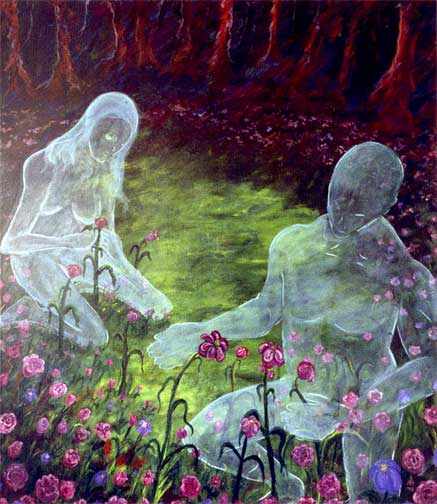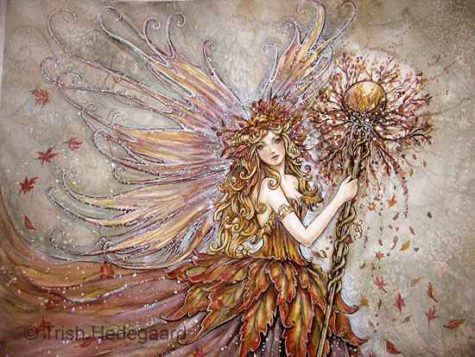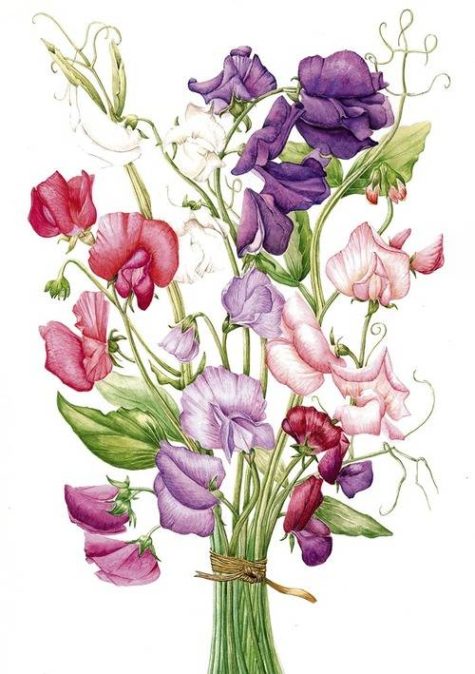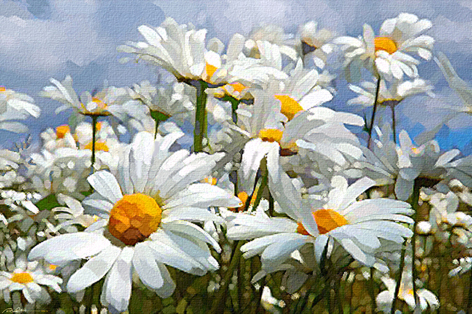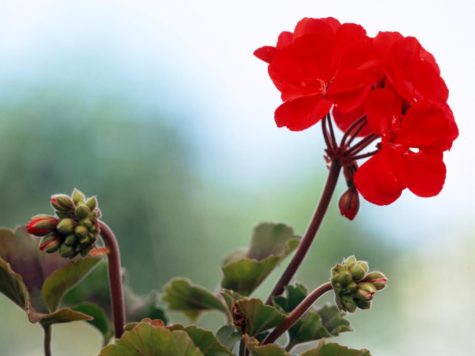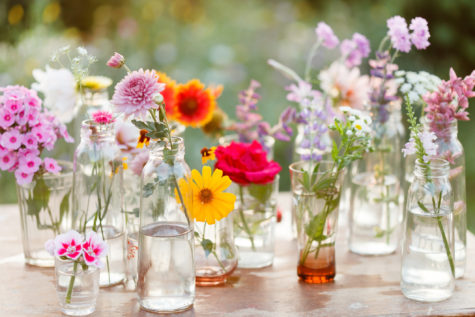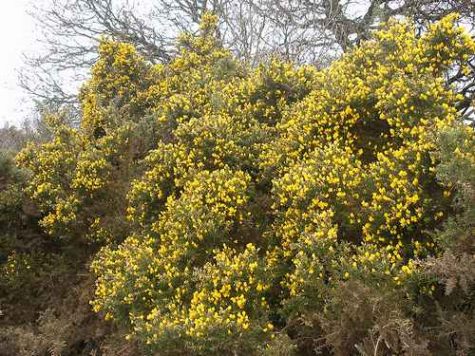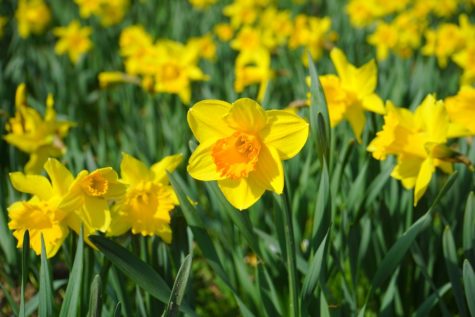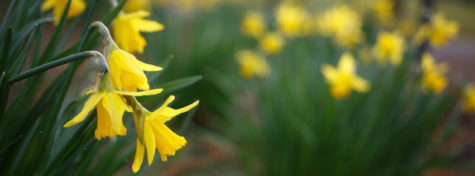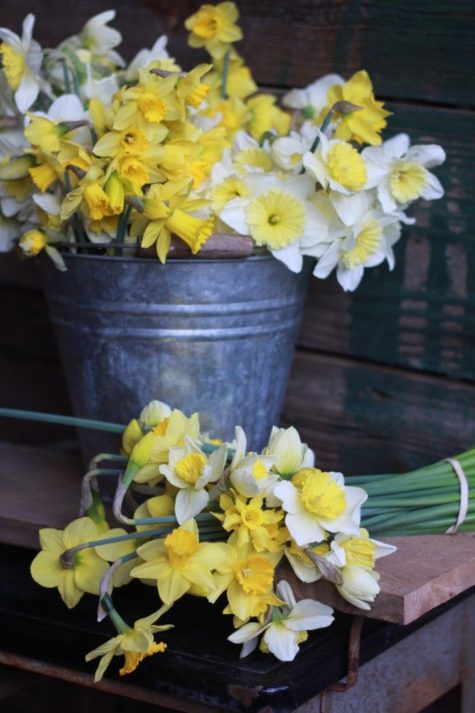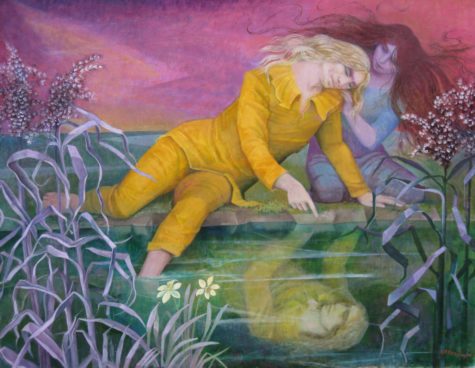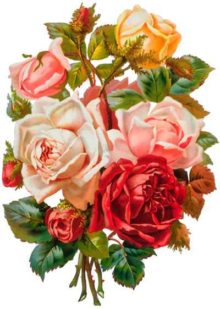Flowers
Various botanicals are said to discourage the presence of ghosts, especially rue and garlic. Here is a list of more botanical ghost busters and how to use them:
A strong scent of real carnations discourages and pacifies ghosts. Synthetic scents will not have the same effect. The best method is to strategically place bouquets of carnations replacing them as their aroma fades.
Hawthorn repels evil ghosts, while permitting the entry of helpful souls. Maintain a barrier of living hawthorn bushes and trees outside the home or bring branches within; the catch to the latter plan being that hawthorn is among the plants most associated with Fairies. Do not break off a branch without first seeking permission from Fairies, lest ghosts become the least of your problems. Branches found already fallen may be considered a gift and safely retrieved.
Boneset guides ghosts elsewhere, attracting protective, benevolent spirits instead. Boneset may also be used to protect people and animals from “ghost sickness,” the illness that some believe may emerge after extended contact with the dead. The most potent boneset is found growing on or near graves. Supplement it with white pine for added enhancement.
Hang fresh boneset branches over doorways, or burn young boneset branches and twigs within a cauldron to drive away existing ghosts.
To prevent hauntings, surround your home with living bean plants. Not only do beans repel ghosts but allegedly, the plants sing to wandering ghosts, guiding them to the next realm. If you’d like to hear these songs, a shamanic art, sit under the vines while they’re in bloom. Meditate or allow yourself to fall asleep.
Burn dried powdered bistort to banish ghosts, wafting the fragrance as needed.
Fennel can be used to ghost-proof individual rooms or an entire building. It only works on some ghosts but may be worth trying. Stuff keyholes full of fennel to prevent ghosts from entering the room. It also stops them from leaving, so if the ghost is already in the room, it may be trapped.
According to Hildegard of Bingen, ghosts hate pine trees and avoid places where they grow. If it’s not possible to surround your home with living pines, bring small living trees within it and situate them strategically.
Tiger lilies planted near doors and windows allegedly prevents the entry of ghosts.
If a ghost has taken up residence in your home or within another building, hanging alyssum up in every corner of a house will exorcise it.
A wreath of fresh bay laurel leaves posted on your entrance doors signals “No Trespassing” to ghosts. To provide relief from destructive and mischievous ghosts and poltergeist, maintain fresh bay laurel branches and /or leaves within the home. Replace them as their green color fades.
Fumigating an area with camphor and mint is used to send unwanted ghosts in search of new housing. One application may not be sufficient, however. Use repetitions of mystical numbers for reinforcement. Repeat for three, seven, nine, eighteen, twenty-one, or twenty-seven days as needed.
Sprinkle a strong infusion of bayberry inside and around the perimeter of a house to exorcise existing ghosts and repel new ones.
Make a decoction of angelica roots or pour boiling water over the dried, powdered root to make an infusion. Sprinkling this within and around the home is an Iroquois recommendation for exorcising and preventing ghosts.
- Bluebells:
To attract faeries to dance in your garden. On Beltane eve, make an ankle bracelet of “Bluebells” and “jingle” bells to attract helpful fae folk to you.
- Clover:
A sacred faery plant, clovers of all kinds will attract them. Lay seven grains of wheat on a four-leafed clover to see the Faery.
- Elderberry:
Used to make Faery wine, these berries can be burned on a fire to invite the Good Folk to a gathering. Make a homemade brew of Elderberry Wine and you are sure to have some thirsty visitors. It is said that if a human drinks the wine, he or she will be able to see the Faery. If a human should drink Elderberry wine from the same goblet as a Faery being, he will be able to see them forever after.
- Elecampagne:
Also known as Elfswort. This root can be scattered around the home to attract the Sidhe. It can be added to any magick or spell to invoke Faery blessing.
- Foxglove:
The source of the modern heart drug Digitalis, Foxglove can have seriously dangerous results if taken internally. DO NOT INGEST!! Instead, plant Foxglove near your front door to invite the Faery in. Put a dried sprig of Foxglove in a talisman to keep you surrounded in Faery light.
- Heather:
Heather is said to ignite faery passions and open portals between their world and our own. Make an offering of Heather on “Beltane” eve to attract good fae to your garden
- Lilac:
The sweet scent is said to draw Fae spirits to your garden. Lilac and primroses for midsummers eve, will please the Fae.
- Mistletoe:
The most sacred herb of the Druids. Mistletoe is a magickal activator. In Faery spells, use a dash of Mistletoe taken on Summer Solstice to empower your workings with Faery magick.
- Milkweed:
Both Monarch butterflies and fairies like milkweed. If Milkweed is planted in a Witch’s garden, the fey will always be in the area. The silky tassels of the milkweed pods can be added to a dream pillow to not only make it softer, but also to make you dream of fairies. In the Autumn when the pods are bursting and the fluffy seeds are flying across the fields, a wish is granted for each seed that can be caught and then released again.
- Peony:
Peony seeds were once used to protect children from faeries. A garland of the seeds were placed around the child’s neck to keep them safe.
- Poppies:
Said to invoke the faery into your dreams Make a dream pillow of fresh poppies to entice the fae to your dreams.
- Primrose:
When planted in a garden or hung dried on the front door, primroses will attract the company of Faeries. If you have them growing under your care, do not let them die! The Faery will be deeply offended by your carelessness. Primroses are great in container gardens. Tie a pink ribbon around your container of Primroses while chanting; “Sacred roses, hear my cry for your protection, this I tie.”
- Roses:
Roses are loved by the fey so you can plant Roses in your garden to attract fairies. Their sweet scent will lure elemental spirits to take up residence close by. Roses can be used in Faery love spells. When performing the spell, sprinkle rose petals under your feet and dance softly upon them while asking the Faery for their blessing on your magick. Wild Roses are best for this purpose. Say the following spell as you plant your baby Rose bush:
“I ask a fairy from the wild,
To come and tend this wee rose-child.
A babe of air she thrives today,
Root her soul in the Goddesses’ good clay.
Fairies make this twig your bower,
By your magic shall time see her flower!”
- Thyme:
Wearing thyme will increase your ability to see the Sidhe. Sprinkle it at the base of your door, and on window sills to invite the Faery to enter your home.
~collected from a 17th century work
- Ruler: Venus
- Type: Flower
- Magickal Form: Flower, oil
The Sweet Pea is the flower often associated with the month of April. Work with this flower or oil to increase your vulnerability and openness. Sweet Pea helps to break down emotional barriers and walls of defense It is a great ingredient for lonely people who shut themselves off from others. Use to attract friends who are trustworthy.
Sweet pea oil is one of the most beautiful of all scents. It is worn to attract strangers of all kinds, some of whom may become lovers or friends. Wear as a personal oil.
From: The Encyclopedia of Magickal Ingredients and other sources
- Ruler: Venus
- Gender: Feminine
- Element: Water
- Type: Flower
- Magickal Form: Petals and flowers
- Deities: Freya, Ostara, Aphrodite, Artemis
- Basic Power: Friendship, Courtship, Divination
The Daisy is traditionally assigned to the month of April. A flower of friendship and courtship, the daisy is used to open up social or romantic opportunity. Add the petals to bathwater on Wednesdays to draw new friends. Place whole flowers on a love altar with pink candles to attract romantic possibilities.
Modern practices include the growing of Daisies as an herb to further attract the Devas and the Fae. Grieve’s “A Modern Herbal” suggests there may be an association between Daisies and a Dryad (a woodland nymph) named Belidis. Dryads are often associated with elemental Earth, and Daisies may be used ritually to help one commune with this element.
Decorate your altar or home with Daisies for Midsummer’s Eve. There is also a Magickal association with babies and newborn infants. The Daisy may be incorporated into baby blessings, or used to bring protective Magick into the baby’s sleeping area.
In Scotland because children use it to make daisy chains; daisy is an appropriate herb to decorate the cradle and the altar. The daisy brings love when worn. Sleeping with the root beneath your pillow may cause an absent love to return.
Decorate the house with daisies at Midsummer’s Eve to bring happiness to the home and to obtain the blessings of faeries. Daisies are also worn at Midsummer for luck and blessings. In the old times, young maidens would weave and wear daisy chains in their hair to attract their beloved.
Dreaming of Daisies is considered good luck in Spring, and bad luck in Winter. It is lucky to step on the first flowers in the spring but extremely unlucky to uproot them. Daisies were popular in Medieval times, when knights at tournaments wore the flower, while their ladies wore Daisy wreaths as crowns.
The daisy is the emotional and intellectual “getting to know you” flower. It is not a flower of passion and it is a great choice for young men and women who prefer a long courtship based on friendship and common goals.
Daisy divinations:
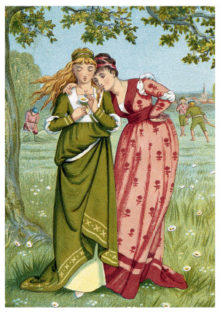 Daisy flowers are perhaps the best known of all plant divinations for love. One of the most touching literary allusions to the daisy divination is found in the garden scene in the first part of Goethe’s famous drama, Faust. In Germany, the daisy was known as:
Daisy flowers are perhaps the best known of all plant divinations for love. One of the most touching literary allusions to the daisy divination is found in the garden scene in the first part of Goethe’s famous drama, Faust. In Germany, the daisy was known as:
- Orakelblume – Oracle Flower
- Liebesblume – Love Flower
- Massliebchen – Little Measure of Love
Divination with daisies most commonly consists of removing each petal from the daisy while saying “she loves me, she loves me not.” (The masculine pronoun is used where appropriate.) The sentence stated as the last petal removed reveals the truth. Any daisy-like flower can be used.
This technique can be further improved upon by placing daisy roots under your beneath your pillow to dream of your true love.
A second form of daisy divination isn’t limited to matters of love. Ask a binary question. As you pluck each petal, say yes or no. As the last petal falls, the answer has been given.
A very short poem from the 1800’s gives us this variation:
- He loves me
- He don’t
- He’ll have me
- He won’t
- He would if he could
- But he can’t
- So he won’t
Another form of daisy divination is as follows:
Get a bunch of daisies and put them on a table. With eyes closed, take a handful while asking how many days you will wait to be asked for a date. If you prefer, you may ask in weeks or months. Open your eyes and count the picked daisies. The number of flowers represents the number of days you will wait. This can also be used to count the time till you will marry.
This can also be done while sitting on a daisy-laden lawn, closing your eyes and grabbing a handful of grass. The number of daisies you end up with in your hand will determine the number of months until you marry. If you do not have access to a daisy filled yard, dandelions make for an acceptable substitute.
Collected from various sources
- Ruler: Moon, Mars
- Element: Water
- Type: Flower
- Magickal Form: Flower, Oil
- Basic Powers: Love, Healing, Protection
The geranium is a popular house and garden plant, not only because it is bright, cheerful, and hardy but also because it magically repels evil spirits. Maintain protective boundaries with geranium essential oils, or strategically place individual plants.
This positive and affirming flower is best for increasing self-confidence and healing a blow to the ego. The geranium soothes a broken heart. Rub into white candles to help make a serious decision about whether to stay or leave a relationship.
Wear the flowers or add them to love sachets. The white variety is worn to promote fertility, while the red are a good protection and aid healing. Plant the flowers in the garden (especially the pink and red) to protect the house and to keep snakes away from your property.
From: Encyclopedia of Magickal Ingredients and other sources
As spring arrives, our gardens begin to bud and eventually bloom. For hundreds of years, the plants that we grow have been used in magic. Flowers in particular are often connected with a variety of magical uses. Now that spring is here, keep an eye out for some of these flowers around you, and consider the different magical applications they might have.
- Crocus:
This flower is one of the first you’ll see in the spring, and it’s often associated with newly blooming love. The crocus is also known to enhance visions and bring about intuitive dreams.
- Daffodil:
The bright petals of the daffodil are typically found in shades of white, yellow or even pale orange. This flower is associated with love and fertility — place fresh ones in your home to bring about abundance. Wear this flower close to your heart to draw love and luck.
- Dandelion:
The leaf of the dandelion is used for healing, purification, and ritual cleansing. To bring positive change about, plant dandelions in the northwest corner of your property. The bright yellow flowers can be used in divination, or placed in a sachet to draw good energy your way.
- Echinacea:
Also called purple coneflower, this garden mainstay adds a little bit of magical “oomph” to charms and sachets. Use it for prosperity related workings. Burn the dried flowers in incense, and use on your altar during ritual as an offering to deities.
- Goldenseal:
This sunny yellow flower is often found growing in the wild, alongside roads and in fields. Use it in money spells, or for business dealings. Work it into charms connected to matters of financial gain or legal issues.
- Hibiscus:
This lusty flower incites passion — use it to attract love or lust, or for prophetic dreams about your lover. Burn in incense, or carry in a sachet to bring love your way.
- Hyacinth:
This flower was named for Hyakinthos, a Greek divine hero who was beloved by Apollo, so it’s sometimes considered the patron herb of homosexual men. Hyacinth is also known to promote peaceful sleep, and guards against nightmares. Carry in an amulet to help heal a broken heart or to ease grief when a loved one dies.
- Lily:
The Easter lily or Tiger lily is associated with all kinds of Spring connections — fertility, rebirth, renewal and abundance.
- Narcissus:
Named for another Greek figure, the Narcissus helps promote polarity and harmony. Its calming vibrations bring about tranquility and inner peace.
- Tulip:
The tulip appears in many different colors and varieties, but is typically connected to prosperity. You can use the different colored variations in color magic — use a dark strain such as Queen of the Night for full moon rituals, or bright red flowers for love magic.
- Violet:
In Roman myth, the first violet sprung from the spilled blood of the god Attis, who killed himself for Cybele, the mother goddess. However, today the violet is associated with tranquility and peace. The leaf offers protection from evil, and can be sewn into a pillow or sachet for a new baby. Carry the petals with you to bring about luck and enhance nighttime magic.
Furze (also known as Gorse) is a druid Sacred tree, whose flowers are associated with the Vernal Equinox (Aprox. March 20).
- Latin name: ulex europaeus
- Celtic name: ‘O’ – Onn
- Folk or Common names: Broom, Frey, Furze, Fyrs, Gorst, Goss, Prickly Broom, Ruffet, and Whin.
- Parts Used: Flowers
Magical History and Associations:
Furze is a thorny shrub with bright yellow flowers that is associated with the Spring Equinox. This herb is a symbol of the young sun at the spring equinox and royalty. Furze is associated with the astrological sign of Aries, the planet of Mars, the element of Fire, and is a masculine herb. Furze is associated with Jupiter, Thor, Onn, and also with the Gallic ash-grove Goddess On-niona. The color for Furze is dun, and its bird is the cormorant.
Magickal usage:
Furze is a symbol of fertility and has the magickal uses of Protection and Money. Furze is also used in money spells; it attracts gold. Furze is a good herb to use as a proctectant against evil. In Wales hedges of the prickly Gorse are used to protect the home against dark fairies, who cannot penetrate the hedge. Furze wood and blooms can be burned for protection and also for preparation for conflict of any sort. There are two school of thought about giving Furze flowers as a gift. On one had the gift is supposed to be good luck, but on the other hand if you give them to someone that you love it means: Anger.
There is an old rhyme about Furze that refers to its all-year-round flowering habits:
“When Gorse is out of bloom,
Kissing is out of season.”
Source: dutchie.org
As spring arrives, our gardens begin to bud and eventually bloom. For hundreds of years, the plants that we grow have been used in magic. Flowers in particular are often connected with a variety of magical uses. Now that spring is here, keep an eye out for some of these flowers around you, and consider the different magical applications they might have.
Crocus: This flower is one of the first you’ll see in the spring, and it’s often associated with newly blooming love. The crocus is also known to enhance visions and bring about intuitive dreams.
Daffodil: The bright petals of the daffodil are typically found in shades of white, yellow or even pale orange. This flower is associated with love and fertility — place fresh ones in your home to bring about abundance. Wear this flower close to your heart to draw love and luck.
Cowslip: The fragrance has healing properties.
Dandelion: The leaf of the dandelion is used for healing, purification, and ritual cleansing. To bring positive change about, plant dandelions in the northwest corner of your property. The bright yellow flowers can be used in divination, or placed in a sachet to draw good energy your way.
Echinacea: Also called purple coneflower, this garden mainstay adds a little bit of magical “oomph” to charms and sachets. Use it for prosperity related workings. Burn the dried flowers in incense, and use on your altar during ritual as an offering to deities.
Goldenseal: This sunny yellow flower is often found growing in the wild, alongside roads and in fields. Use it in money spells, or for business dealings. Work it into charms connected to matters of financial gain or legal issues.
Hibiscus: This lusty flower incites passion — use it to attract love or lust, or for prophetic dreams about your lover. Burn in incense, or carry in a sachet to bring love your way. Red Hibiscus flowers are used in love potions and placed in wreaths in marriage ceremonies.
Hyacinth: This flower was named for Hyakinthos, a Greek divine hero who was beloved by Apollo, so it’s sometimes considered the patron herb of homosexual men. Hyacinth is also known to promote peaceful sleep, and guards against nightmares. Carry in an amulet to help heal a broken heart or to ease grief when a loved one dies.
Lily: The Easter lily or Tiger lily is associated with all kinds of Spring connections — fertility, rebirth, renewal and abundance.
Marigold or Calendula: Add calendula to your bath to win the respect and admiration of your peers. String garlands of calendula around the outside doors to stop evil from entering the house.
Morning Glory: Morning Glory seeds under your pillow will stop nightmares. Grown in the garden, blue morning glories will bring peace and happiness.
Narcissus: Named for another Greek figure, the Narcissus helps promote polarity and harmony. Its calming vibrations bring about tranquility and inner peace.
Passion Flower: Placed in a house, it calms problems and troubles and brings peace. Carried, it attracts friends and popularity. Placed beneath the pillow, it aids in sleep.
Rose: Used in love and harmony spells. Roses planted in your garden will attract fairies. Rose petals sprinkled around the house will calm stress and reduce household upheavals.
Snapdragon: Place a vase of fresh snapdragons on the altar while performing protective rituals. If someone has sent you negativity energy (hexes, curses, etc.), place some snapdragons on the altar with a mirror behind them to send the negative energy back to the sender.
St. John’s Wort: wards off fevers and cold when worn; burn to banish evil spirits; gather it on a Friday and wear it to cure melancholy — (also known as Hypericum).
Sunflower: Sunflowers growing the garden guard it against pests and grant the best of luck to the gardener.
Tulip: The tulip appears in many different colors and varieties, but is typically connected to prosperity. You can use the different colored variations in color magic — use a dark strain such as Queen of the Night for full moon rituals, or bright red flowers for love magic.
Violet: In Roman myth, the first violet sprung from the spilled blood of the god Attis, who killed himself for Cybele, the mother goddess. However, today the violet is associated with tranquility and peace. The leaf offers protection from evil, and can be sewn into a pillow or sachet for a new baby. Carry the petals with you to bring about luck and enhance nighttime magic.
Source unknown
- Ruler: Venus
- Element: Water
- Parts Used: The flowers, either fresh or dried.
- Powers: Love, fertility, luck
Symbolizing rebirth, resurrection, renewal and new beginnings, the daffodil is virtually synonymous with spring. Though their botanic name is narcissus, daffodils are sometimes called jonquils, and in England, because of their long association with Lent, they’re known as the “Lent Lily.”
The Daffodil is a calming flower that helps bring about inner peace, hope and, of course, self-love. It may also be used in spells related to unrequited love. To dream about seeing or picking daffodils is said to symbolize happiness and adoration.
The name daffodil is a derivitave of affodell, which is a variant of asphodel. The Latin name for the daffodil is narcissus. Narcissus are also referred to as jonquils in North America.
- The daffodil is the emblem of Wales and is worn on St David’s Day.
- For spring flowers the daffodil is one of the best bulbs to plant.
- As the daffodil is one of the first flowers of spring, it has the flower meaning of hope.
Daffodil commonly refers to narcissus with large trumpets, but may be used for all types of narcissus. This is the official common name for ANY of the plants that fall into the genus Narcissus. So, if the plant is considered a Narcissus, it is also considered a daffodil as well. However, most people use the term “daffodil” when referring to the large, trumpet-shaped flowers of the Narcissus pseudonarcissus.
For the magick and lore of the Narcissus, visit this post: Narcissus Magick and Lore
In Victorian flower language daffodils signified regard and chivalry, whilst narcissi meant self esteem, female ambition or vanity.The daffodil is the March birth flower and the meaning it holds is friendship and domestic happiness.
The March birth flower daffodil that is commonly known, is yellow with a sweet fragrance. It is native to the Mediterranean, but has been cultivated all over the world as a decorative plant. The daffodil is a perennial grown from a bulb. It can reach heights of two feet. The daffodil is a dependable spring flower and a favorite for its long life and colorful blooms. It is poisonous if eaten.
Lore connecting the daffodil to not only a sign of winter’s end but a lucky emblem of future prosperity is found throughout the world. In Wales, it’s said if you spot the first daffodil of the season, your next 12 months will be filled with wealth, and Chinese legend has it that if a daffodil bulb is forced to bloom during the New Year, it will bring good luck to your home.
The March birth flower and the 10th wedding anniversary flower, a gift of daffodils is said to ensure happiness. But always remember to present daffodils in a bunch – the same legends that associate this cheerful flower with good fortune warn us that when given as a single bloom, a daffodil can foretell misfortune.
Daffodils are suitable altar decorations for any rituals celebrating the coming of spring and suitable offerings for solar deities, water and nature spirits, especially those identified as female. It should be noted that daffodils are toxic, especially the bulbs and can cause irritation to the skin and so should be used with appropriate caution.
Through folkloric mention, narcissus is a flower of the dead and of the underworld, making it suitable for funerary rites as well as those related to the changing of the seasons through rebirth allegory.
- Sprinkle dried petals or place fresh flowers on an altar to attract friendly spirits.
- Keep in the house or garden to cheer you up.
- Wear a daffodil in your breast pocket for luck and to have a cheerful mood follow you all day.
- Add to bathwater to increase your luck and bring new people into your life.
- A bouquet of daffodils in the bedroom may increase fertility.
- Mix with rose petals and place around a photo of a lover you want to return to you.
- Keep freshly cut daffodils in a vase in your home to bring about abundance.
- Place daffodils on your altar during workings related to love, especially if it’s a new relationship and you’re still trying to figure out how to navigate the waters.
- Add potted daffodil bulbs, don’t worry if they’re blooming yet, to your altar for spring celebrations, along with other spring flowers such as forsythia, crocus, and snowdrops.
- Wear this flower close to your heart to draw love, but be careful that your love is not one-sided.
They are good flowers for Geminis who like the cheerfulness of the yellow color and Pisces who appreciate the delicate scent of the white narcissi.
Daffodils in Mythology
Daffodils are also known as the narcissus, after the legendary young Greek man of the same name. Narcissus was pretty full of himself because he had been given the gift of great beauty by the gods. One day, a sweet young wood nymph named Echo spotted Narcissus hanging out by a stream and instantly fell in love with him. However, he was so busy being completely self-absorbed that he ignored Echo, and she wasted away from loneliness until nothing was left of her but her voice. Thanks to this tragic story of unrequited love, daffodils are sometimes used to represent a love that is one-sided.
Later, the goddess Nemesis, although in some versions, it’s Venus, got wind of what had happened to Echo, so she decided it was time to teach Narcissus a lesson. She led him to a stream, where he happened to notice the most beautiful young man he had ever seen – it was his own reflection, and he was so vain that he fell in love with his own image, transfixed, and forgetting to eat and sleep. Some of the other gods were worried that Narcissus was going to starve to death, so they turned him into a flower, which now blooms every year in the spring.
Daffodils in Love
Despite the issues of Narcissus and Echo, daffodils still appear in some folklore as representative of holding a lover in high regard. They send the message that this person is the only one for you, and your feelings are constant.
In some Middle Eastern magic, daffodils are considered an aphrodisiac.
Spiritual Daffodils
One prominent legend of the daffodil features in Christianity. It is said that on the night of the Last Supper, the daffodil appeared in the Garden of Gethsemane to comfort Jesus, who was saddened to know of his betrayal by Judas Iscariot.
The occurrence of wild daffodils is sometimes said to indicate the former site of a religious foundation. At Frittlestoke, near Torrington, Devon, it was recorded in 1797 that the people of the village call daffodils by the name Gregories, a name that coincided with the order of a neighboring monastery – the Canons of St Gregory.
In both Hampshire and the Isle of Wight, it was generally said that wild daffodils indicated the site of a monastery. St Urian’s Copse is well known for its primroses and daffodils. There is a tradition that daffodils grow in profusion on one side of a track running through the copse because a religious building once stood there.
From:
- Encyclopedia of Magickal Ingredients
- Patti Wigington
- Encyclopedia of Superstitions
- Teleflora
- Ruler: Venus, Oshun, Taurus
- Type: Flower
- Magickal Form: Flowers, Oil, Thorn
Roses are a metaphor for the human heart. No flower represents love more vividly. Perhaps nothing does. Roses are sacred to the most powerful spirits of love: Aphrodite, Juno, Isis, Kybele, Maitresse Ezili, and Maria Padilha. Oshun loves yellow roses.
Cleopatra, the living embodiment of Aphrodite and Isis, seduced Marc Anthony in a scented bedroom, packed knee-deep with rose petals.
This scent is generally worn as a perfume to attract love. Often the dried flowers are added to success formulas. This flower is always a good choice to adorn your love altar. Keep the flowers fresh and change them every Friday.
Use white roses for cleansing and to heal problems in love.
Use yellow roses – for friendship, though they can also denote jealousy if not given by a true friend. The Yoruban goddess Oshun loves these flowers. Float five ( or any multiple of five) fresh yellow roses in a river and ask Oshun to fulfill a wish concerning fame, wealth, admiration, or love. Promise to give her more after she fulfills your request.
Red roses symbolize passion and true love. Drink a tea of dried red rosebuds to increase your passion. Prepare a bath with red rose petals and a cup of rosewater or three drops of rose oil to infuse your aura with sexuality.
No other plant is as intimately linked with love as the rose. When selecting healing roses, seek out the old-fashioned scented types such as those listed below, rather than the more neutral tea roses:
- Apothecary’s Rose: the fragrant rose from which a very high quality of rose water is made.
- Belle de Crecy: considered by some to contain the purest rose scent.
- Celestial: a rose with a crisp and clean aroma.
- Kazanlik: a Bulgarian rose oil also called attar of roses is made from this rose. It throws off a potent smell – very heady.
- Maiden’s Blush: is considered to be a more refined scent.
- Madame Isaac Pereire, Guinee, and Souvenir de la Malmaison: are stunning and highly fragrant.
Roses are beautiful and like the lotus, they suggest female genitalia in the height of passion. The blush of the rose is often compared to the blush of a bride or a sexual partner during orgasm. In parts of Africa and the Middle East, holy temples are spiritually cleansed, entirely with highly potent Bulgarian rose water typically called rose hydrosol or simple rose water. Rose hydrosol enhances the sacred environment.
Fresh roses, rose water, rose otto (attar of roses), rose cream, and rose incense all cast a magical spell, binding love and romance.
A little-known fact is that roses are a systemic nervine – translation: they calm and soothe your nerves. Whatever you need – calm, balance, stimulation, an aphrodisiac, cooling off after an argument – rose otto or attar of roses can help. Rose otto is very expensive, but it is also very powerful – a few drops will do the trick! Add 2 drops to a full bath, to a dream pillow, sachet, or mojo bag. (Note: Pregnant women should avoid the use of rose otto.)
Bulgarian roses are widely available in East Indian shops and health food stores, prepared as a rose water that can be put into a spray bottle. Rose water is considered cleansing, a blessing oil that also purifies the environment.
Found in:
